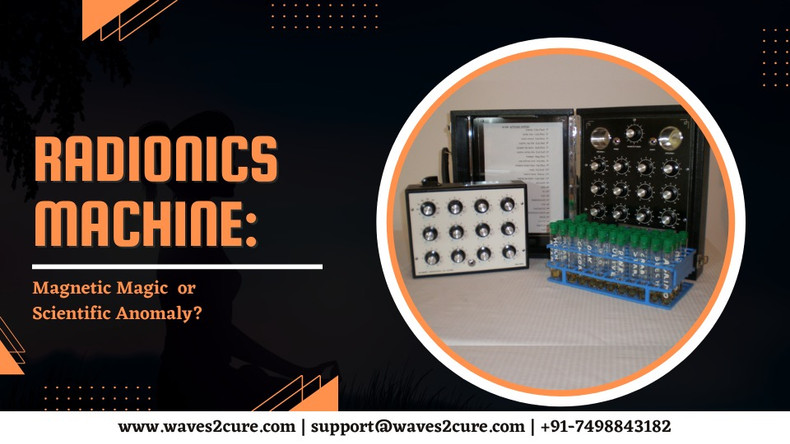Radionics machines have been around for over a century, and various researchers ranging from doctors to engineers have contributed to their advancement. In this article, learn more about the history and operation of radionics machines.
What is radionics machine?
The term "radionics," which combines the words "radio" and "electronics," was coined in the 1930s by Dr. Albert Abrams, a renowned American physician who invented the first radionics machine. Following Dr. Abrams, many other researchers and scientists, including Ruth B. Drown, Thomas Galen Hieronymus, and George de a Warr, contributed to the development of radionic machines. Thomas Galen Hieronymus was the first to obtain a US patent in 1949 for his machine, known as the Hieronymus machine..
According to quantum physics, the foundation of radionics, all matter in the universe is made up of energy and vibrates in accordance with its own frequencies. All matter share the characteristics of both waves and particles. This means that all substances, including all cells and organs, as well as viruses, bacteria, pollen, toxins emits electromagnetic waves. Radionics is based on the following hypothesis:
- Everything is energy
- Everything is interconnected.
- Everything emits electromagnetic waves or radiant energy(light). This radiant energy is also known as subtle energy field, aura, intrinsic data field, or information field.
- Information, Energy, and Matter dynamically interact with each other and changes to one affects the other two.
Radionics machines by Dr. Albert Abrams
Dr. Albert Abrams(1863 to 1924) was an American physician who pioneered radionics at the turn of the twentieth century. Dr Abrams believed that the diseased human body was in electrical dissonance, producing a change in measurable resistance (in ohms) in the human body according to the condition. He is known as the "Father of Radionics" because of his extensive research into detecting life force emissions using instrumental methods.
Albert Abrams invented several radionics machines, including the Reflexophone for diagnosis and the Oscilloclast for treatment.
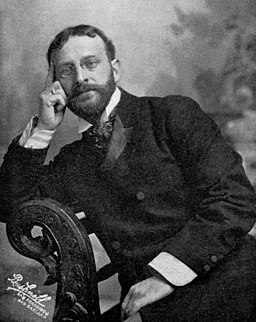
Reflexophone
There is an intriguing story about what inspired Albert Abrams to develop his first radionics device, the Reflexophone.
Abrams discovered that tapping on the abdomens of his patients with cancerous lip ulcers produced a dull sound when facing west and a hallow sound when facing any other direction. This was true for every type of cancer. Abrams called this discovery the Electronic Reaction of Abrams or E.R.A.
After much experimentation Abrams found that the diseased tissue also had an effect on a healthy third person. He also established that if both the patient and healthy person stood on copper plates connected by wire then tapping on abdomen of a healthy person produced the same dull sound.
Abrams concluded that:
- Disease is a form of electron imbalance in the atoms of diseased tissue (rather than cellular imbalance), and that disease could thus be studied as a form of radiating energy.
- Radiating energy from diseased tissue may be detected after passing through a healthy person's body/tissues and/or along a wire.
Abrams thought that if the phenomenon was a ‘radiation’ from the diseased tissue, then it could be electronic in nature. Based on this concept, Abrams created the Reflexophone, the first Radionics diagnosis machine. The patient no longer had to be present, but they could send a "witness sample" from across the country, such as a blood sample, a lock of hair, some handwriting, or a photograph. Abrams claimed that contact with the patient could be maintained by using a 'witness,' which provides an exact energy replica of the patient.
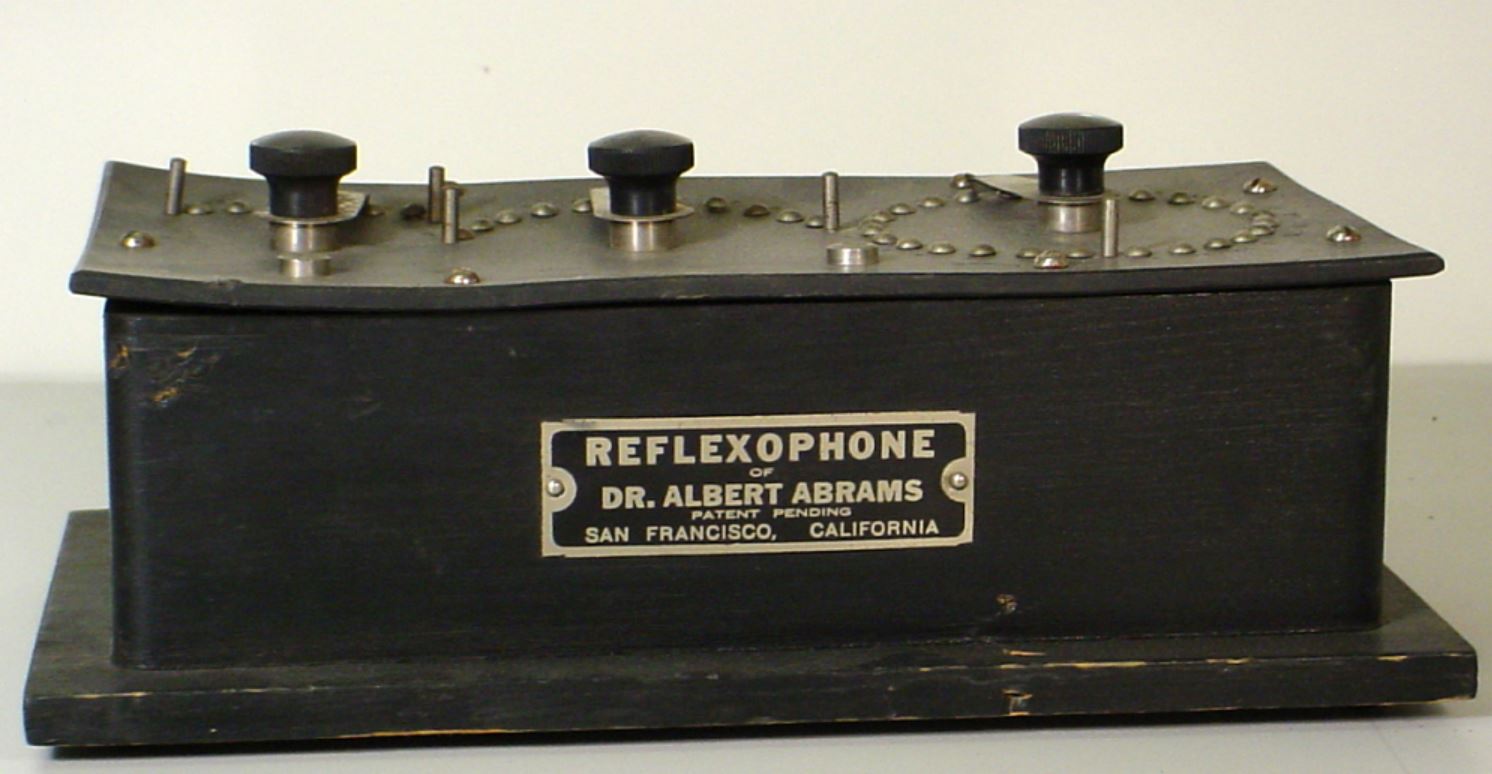
The Radionics practitioner would place the witness sample in a small holder connected to multiple Reflexophones and other black boxes. The whole was attached to a pair of foot plates on which a healthy man known as "the reagent" stood. The Practitioner would tap the reagent's tummy while twiddling the knobs, looking for 'dull sounds.' The diagnosis was made based on the location of the dull sound, as well as the dial settings at the moment of the thud.
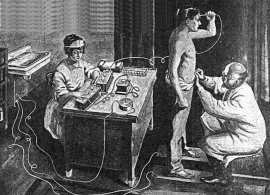
The Reflexophone enabled the diagnosis of a patient's ailment by thumping someone else's belly.
Oscilloclast
Dr. Albert Abrams proposed that all body parts, including diseased ones, had a specific vibration rate. If the vibration rate of the diseased part could be determined, that frequency could be sent back into the body to cure the disease. He created the Oscilloclast, which could play back electronic waves into the body thus “creating harmony and curing the body from disease.”
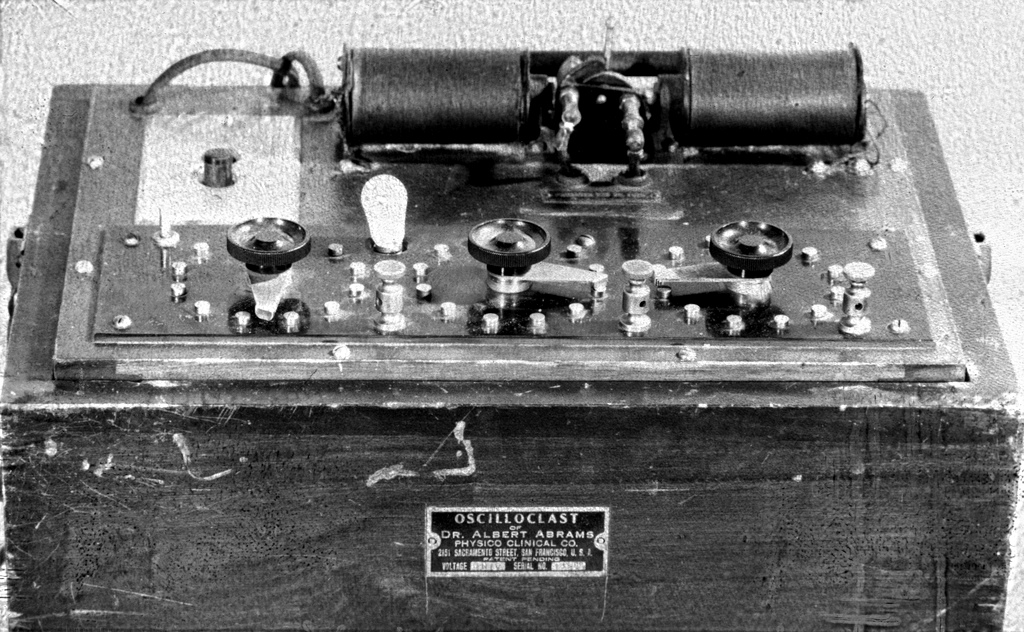
The original Oscilloclast was a long rectangular black box with three rotary Rate switches, a switch button, a light bulb, and four binding terminal posts. This machine could be connected to a patient or an "energy link" from the patient, such as blood or hair samples; this "energy link" was also referred to as a "witness."
Radionics machine by Dr. Ruth B. Drown
Ruth Beymer Drown (1891–1955) was an American chiropractor who studied under Dr. Albert Abrams. When comparing Ruth Drown's work to that of Albert Abrams, her revolutionary approach to radionics is obvious. She discovered that radionic energies were more life-related and cosmic than her mentor Dr. Albert Abrams had thought. Abrams' medical research was rigorously scientific, based on physical theories of the day; whereas Ruth Drown discovered that the foundation of "radionics" was far more subtle and even esoteric than Abrams might have imagined (even with his connections to Theosophy), though she still believed in electron theories. Despite superficial similarities, the work of these two radionics pioneers cannot be truly compared. They were both geniuses, but they had very different ideas and insights.
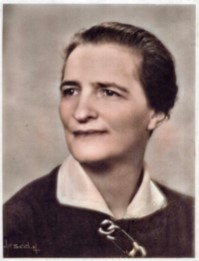
Drown made Abrams' instruments more precise and elaborate. Drown took it a step further by creating the radionics detector/stick pad as a direct replacement for bumping off a person's abdomen, which tested and reproduced the same results. The "stick pad" was born from this.
Drown rose to prominence in radionics. she used "sick pad" with great success in expanding Abrams' rates tables for anatomy and diseases. Furthermore, Drown was the first to propose the concept of treatment at a distance. Ruth Drown developed two significant radionics devices, the "Drown Radio Therapy Instrument" and the "Drown Radio Vision Instrument," which are collectively known as "Homo-Vibra Ray Instruments."
Ruth called her work "Radio-Therapy," not because her devices were radios, but because they "did tune into the energy emanating from the Human, Animal, Vegetable, and Mineral Kingdoms." When the "witness" is placed in the Drown instrument, the patient's energy (life force) is drawn through the instrument, and with proper tuning, it is possible to diagnose, treat, or make a picture of the part of the body that sent it out.
Drown Radio Therapy Instrument
Ruth Drown, five years after Dr. Abrams' death, introduced her first radionic instrument, the "Drown Radio Therapy Instrument," in 1929; she claimed it could cure any patient in the world using a blood sample.
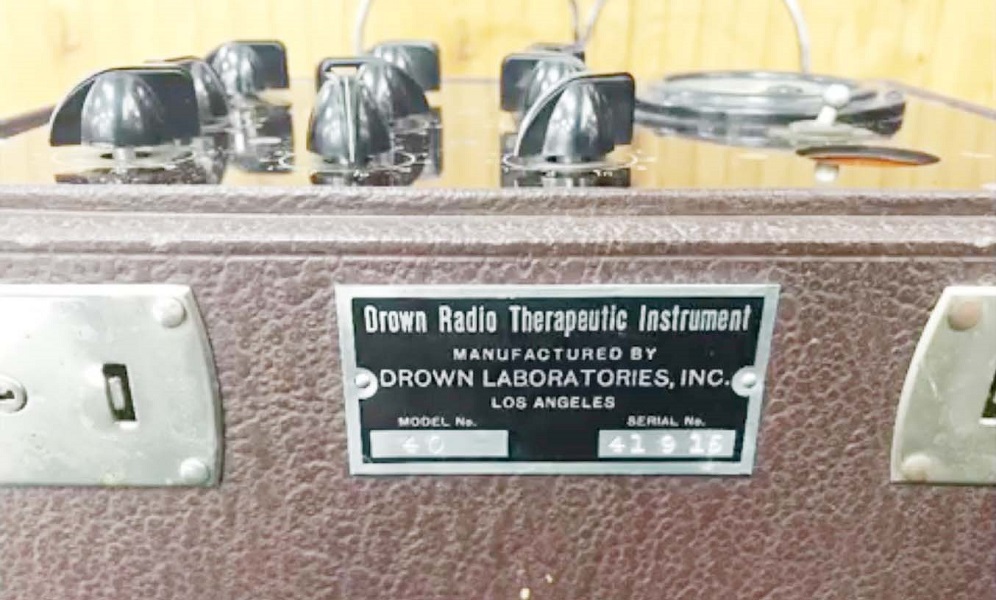
The Drown instrument at first had seven dials, but she very soon began using nine dials on all her devices. Each of the nine dials was a rotary switch having positions numbered 0 to 10. Her instruments added no electricity or power to the radionic circuit; rather, the instrument was powered by the life force, or subtle vital energy, of the person or substance being examined.
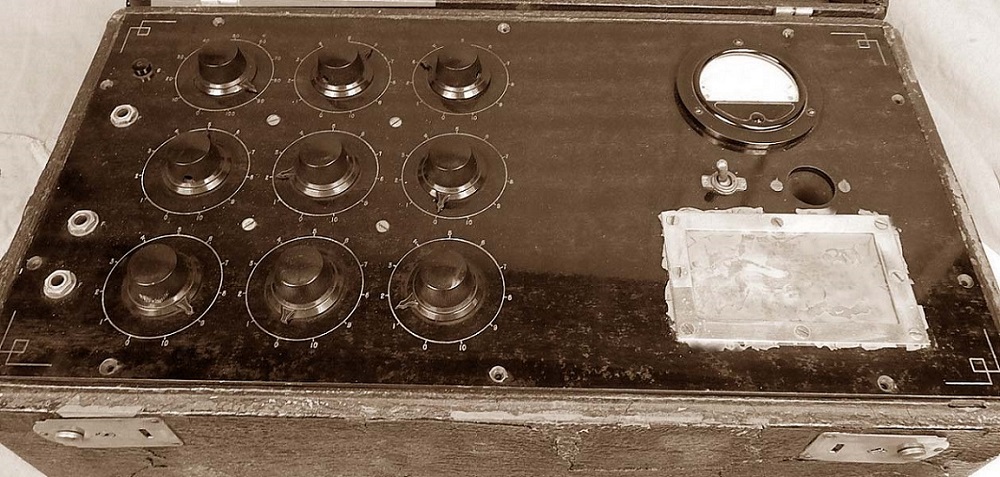
Drown Radio Vision Instrument
In 1935, Ruth created the Drown Radio-Vision, a radionic camera that could take X-ray-like cross-section photographs of hidden and remote conditions using nothing more than a blood spot on paper and tuning the instrument's rate dials.
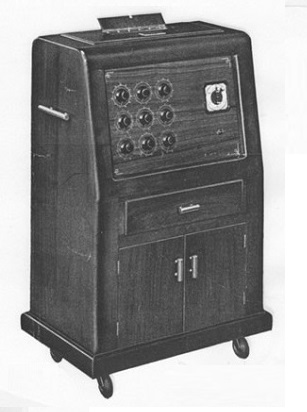
The camera allowed no visible light to contact the film, yet many photos were developed, revealing images of foetuses, diseased conditions, or cross-sections of organs, depending on who and what the Ruth consciously tuned into.
Radionics Machines of George De La Warr
George Walter de la Warr (Northern England, 1905-1969) was the first person in the United Kingdom to manufacture radionic devices based on Ruth Drown's concept in 1941 and later developed their own design. De la Warr and his wife worked hard and researched radionics.
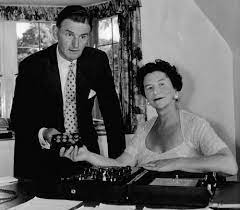
There is an interesting story about how George de la Warr took up the torch and became a leading light in the world of radionics. Dr. Ruth travelled to England with some of her radionic instruments shortly before the Second World War, where she taught her methods to several people. Ruth Drown's radionics machines were in high demand in the UK, but import restrictions made it impossible to receive any more instruments during the 1939-1945 war. During those years of scarcity, someone asked a friend who was an engineer to make him a Drown instrument replica. That friend was none other than George de la Warr,
George de la Warr began developing radionic devices based on Ruth Drown's concept in 1941, and later established the De La Warr Laboratories in Oxford, England, where he conducted research and built many radionic devices based on his own designs. De la Warr also established the Radionic Association in England in 1943, which was the world's first professional society of qualified Radionic practitioners.
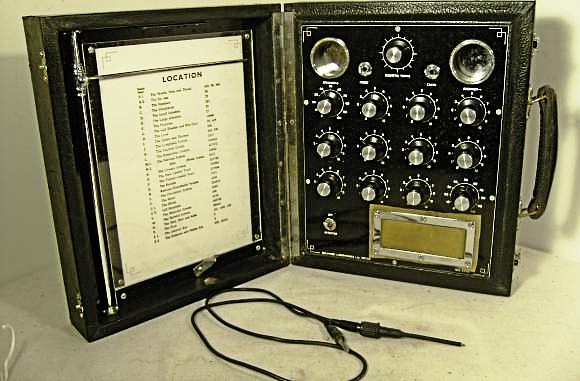
De la Warr instruments based on his own design differed from Drown instruments in several ways, including:
George de la Warr also served in the British army as a captain in the Royal Engineers and later worked for Oxfordshire County Council as a civil engineer.

